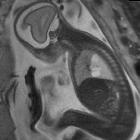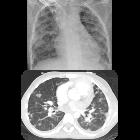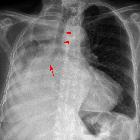pulmonary cavity
 ähnliche Suchen
ähnliche Suchenpulmonary cavity
lung cavity
Lung cavitating lesion
Lung cavitating lesions
Lung-cavitating-lesions
Cavitatory pulmonary disease
Cavitatory lung diseases
Cavitatory lung disease
Cavitating lung lesions
Lung-cavitary-lesions
Lung cavities
Pulmonary cavitiation
pulmonary cavities
cavitating lung mass
cavitating pulmonary mass
cavitating lung lesion
differential of a pulmonary cavity
pulmonale Kavernen
multiple pulmonary cavities
multiple small pulmonary cavities
cavernous pulmonary lesions
pulmonary cystic lesion
Pulmonary cavitiations
 siehe auch
siehe auchLangerhanszell-Histiozytose der Lunge
Lungenkarzinom
Bronchogene Zyste
pulmonale Tuberkulose
Lungensequester
Lungenrundherd
Lungenabszess
Lymphangioleiomyomatose
Lungenzysten
Granulomatose mit Polyangiitis
multiple zystische Lungenherde
septische Embolie Lunge
Lungenmetastasen
kongenitale pulmonale Atemwegsmalformation (CPAM)
pulmonale Vaskulitis
Plattenepithelkarzinom
kavernisierende Lungenmetastasen
Lungeninfarkt
CAVITY
pulmonale Raumforderung
kavernisierende Pneumonie
zystische Lungenmetastasen
Pulmonary cavities are thick-walled abnormal gas-filled spaces within the lung. They are usually associated with a nodule, mass, or area of consolidation. A fluid level within the space may be present. Plain radiography and CT form the mainstay of imaging.
Terminology
According to the Fleischner Society, pulmonary cavities are defined as "a gas-filled space, seen as a lucency or low-attenuation area, within pulmonary consolidation, a mass, or a nodule" .
Pathology
The cause of pulmonary cavities is broad. They may develop as a chronic complication of a pulmonary cyst or secondary to cystic degeneration of a pulmonary mass. They may enlarge or involute over time.
Etiology
Pulmonary cavities may be the result of malignancy, infection, inflammation, or be congenital:
- cavitating malignancy
- primary bronchogenic carcinoma (especially squamous cell carcinoma)
- cavitating pulmonary metastases
- squamous cell carcinoma
- adenocarcinoma, e.g. gastrointestinal tract, breast
- sarcoma
- infection
- pulmonary tuberculosis
- pulmonary bacterial abscess/cavitating pneumonia
- post-pneumonic pneumatocele: a thin walled pneumatocele is not really a cavity but when infected can be thick-walled
- septic pulmonary emboli
- other rare infections
- non-infective granuloma
- vascular
- trauma
- pneumatoceles (a thin-walled pneumatocele is not really a cavity)
- congenital (not true "cavity")
A helpful mnemonic is CAVITY.
See also
- pulmonary mass
- pulmonary cyst
- pulmonary cavity
- pulmonary nodule
Siehe auch:
- Pneumatozele
- Langerhanszell-Histiozytose der Lunge
- Lungenkarzinom
- Bronchogene Zyste
- pulmonale Tuberkulose
- Lungensequester
- Lungenrundherd
- Lungenabszess
- Lymphangioleiomyomatose
- Lungenzysten
- Granulomatose mit Polyangiitis
- multiple zystische Lungenherde
- septische Embolie Lunge
- Lungenmetastasen
- kongenitale pulmonale Atemwegsmalformation (CPAM)
- pulmonale Vaskulitis
- Plattenepithelkarzinom
- kavernisierende Lungenmetastasen
- Lungeninfarkt
- CAVITY
- pulmonale Raumforderung
- kavernisierende Pneumonie
- zystische Lungenmetastasen
und weiter:
- Tuberkulose
- einschmelzende Pneumonie
- Pleuraempyem
- pulmonary cavity (mnemonic)
- mixed-type hiatal hernia mimicking pulmonary cystic lesion
- necrobiotic lung nodules
- pulmonale Kryptokokkose
- Rasmussen-Aneurysma
- extrapulmonale Manifestationen der Tuberkulose
- Monod-Zeichen
- Lymphom Kaverne
- cystic pneumocystis jirovecii pneumonia
- Punkte in Lunge
- cavitary necrosis complicating pneumonia
- hyperdense pulmonale Raumforderungen
 Assoziationen und Differentialdiagnosen zu Kavernöse Lungenläsionen:
Assoziationen und Differentialdiagnosen zu Kavernöse Lungenläsionen:





























